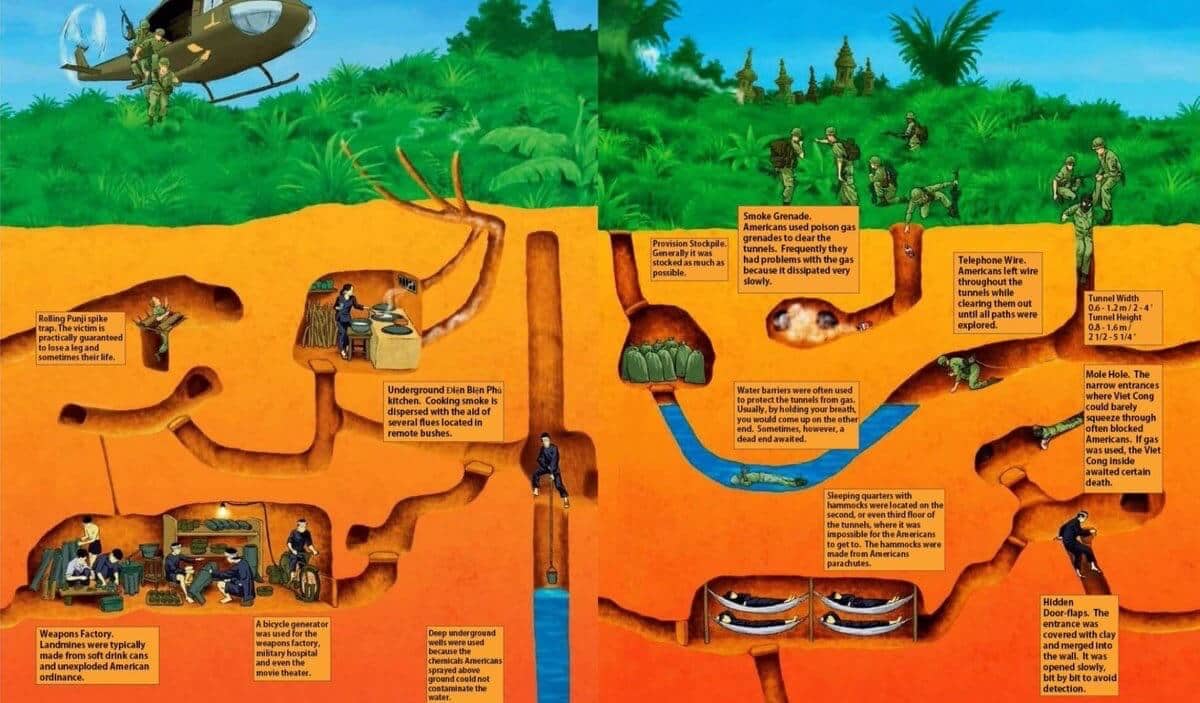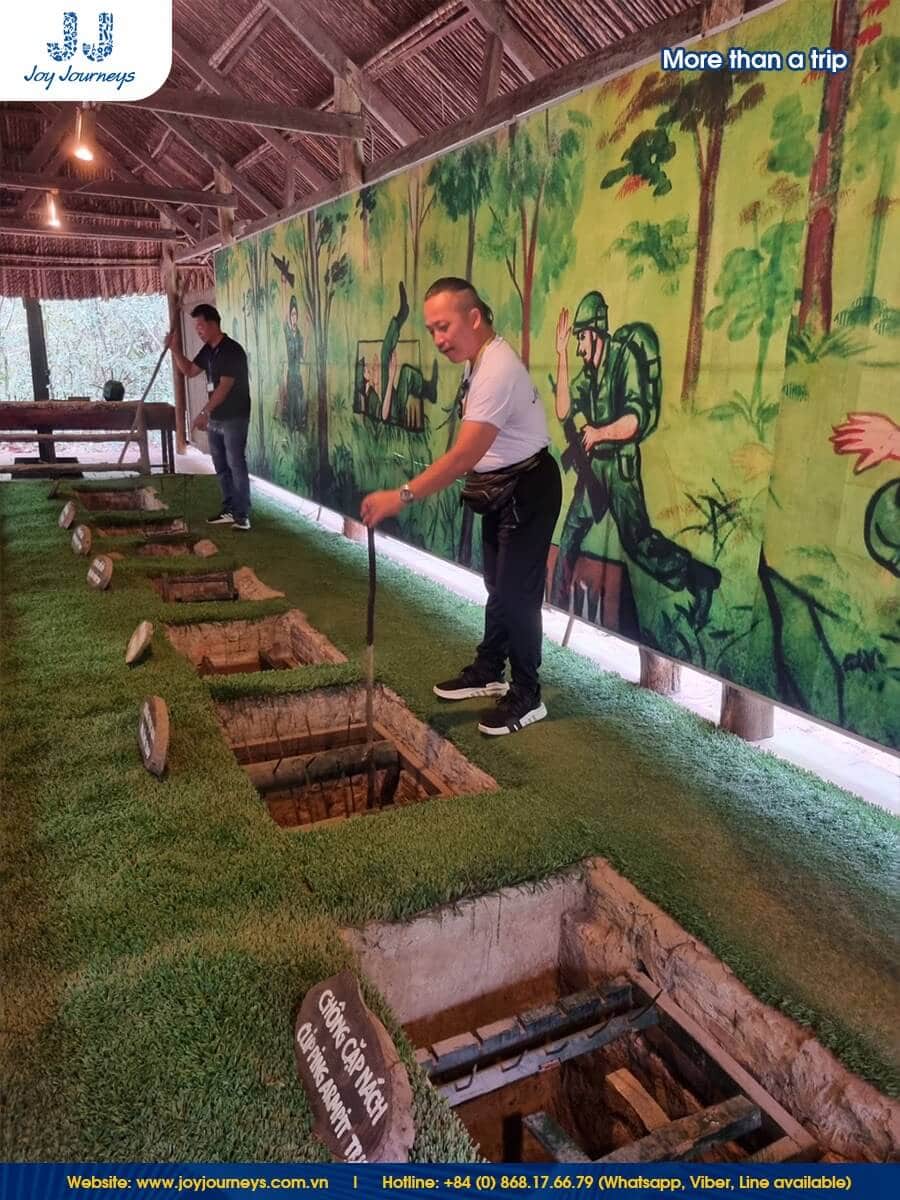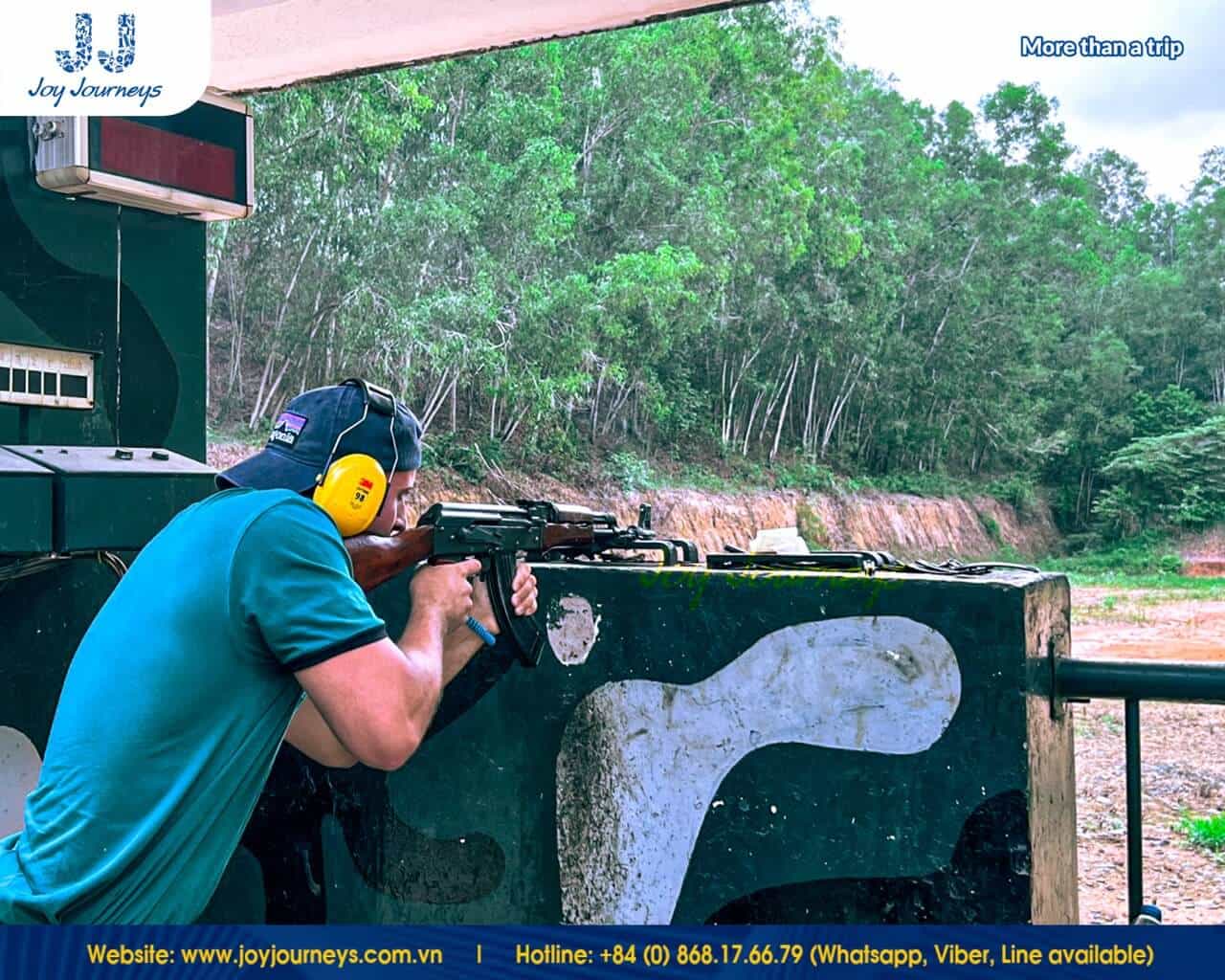The Cu Chi Tunnels are one of the most significant historical sites from the resistance war against the U.S. They served not only as a formidable defense line for soldiers but also as a sanctuary for entire armies and villages, protecting countless Vietnamese lives.
With Joy Journeys’ Cu Chi Tunnels Unveiling the Secrets of Underground Warfare, you can explore this incredible underground world and discover its vital role in Vietnam’s history.
Contents
The Cu Chi Tunnels: An Underground Labyrinth
The Cu Chi Tunnels, stretching up to 250km, boast a long and fascinating history.
Origins and Expansion
The Cu Chi Tunnels, a remarkable underground network, began in 1948 during the Indochina War. Initially, residents of Tan Phu Trung and Phuoc Vinh An communes dug simple, short tunnels to escape French raids and protect Viet Minh soldiers. Over time, these individual tunnels were connected, creating an increasingly intricate system spanning several villages and communes.
By 1961-1965, the tunnel network had expanded significantly. A central “backbone” tunnel linked numerous branches, forming a vast, multi-layered system over 200km long. The tunnels ranged in depth from 3 to more than 12 meters as living quarters, medical stations, weapons depots, and strategic meeting points.
Extensive surface defenses, including minefields and spike pits, fortified the tunnels, transforming the area into a stronghold for guerrilla warfare. By 1965, the Cu Chi Tunnels had become a major base for resistance efforts, showcasing the ingenuity and resilience of their creators.
With Joy Journeys’ Cu Chi Tunnels Unveiling the Secrets of Underground Warfare, you can explore the incredible history of this underground labyrinth.

Life in the Tunnels
During the war, soldiers and civilians spent more time living underground than above ground.
This harsh environment meant they had to cope with the absence of light, high humidity, intense heat, and poor sanitation.
As a result, they often suffered from skin, digestive, and parasitic diseases. Food shortages were also a constant struggle, as preserving and transporting food in such conditions was incredibly difficult.
Hidden Chambers and Secret Passages
The tunnel system features carefully concealed vents and ventilation holes designed to maintain air circulation without compromising secrecy. Specially designed stoppers were also used to prevent toxic gases from accumulating inside.
The entrances and exits of the tunnels were expertly disguised as termite mounds, piles of earth, bushes, and other natural features to ensure maximum secrecy and safety. Additionally, anti-tank and anti-infantry minefields were strategically placed and densely interwoven around these areas, further enhancing security.

Unveiling the Secrets of Underground Warfare
Guerrilla Tactics
Faced with a disparity in force size, the Vietnamese army employed guerrilla warfare to launch swift, surprise attacks on the enemy. Guerrilla fighters would strike and retreat before the enemy’s massed counterattacks, turning the vast area north of Cu Chi into a sprawling battlefield.
Since primary weapons, such as firearms and improvised water-pipe guns, required close-range combat within the tunnels, the guerrillas strategically created concealed firing positions. These positions were carefully camouflaged as natural features like mounds, termite mounds,…
Communication and Supply Lines
The tunnel network played a vital role in communication and logistics. Its intricate system of interconnected roads, branches, and tunnels allowed the Viet Cong to transport weapons, food, and other essential supplies while remaining undetected by enemy forces.
Hospitals and Living QuartersHospitals and Living Quarters
The Cu Chi Tunnels functioned like an underground city, complete with distinct areas for various purposes, such as medical rooms, strategy rooms, bedrooms, and kitchens. While not as convenient as living above ground, this system was relatively safe and provided a sense of completeness for those who resided there.
Booby Traps and Defensive Strategies
The tunnels had deadly homemade traps designed to deter or harm intruders. Examples include the “hầm chông bẫy cọp” (booby trap), a hidden pit camouflaged as a flat road, filled with sharp bamboo or iron spikes, and the “chông hòm”, a round tube-like trap with inward-facing spikes that would stab the ankle, immobilizing anyone who stepped on it.

Visiting the Cu Chi Tunnels Today
A Historical and Cultural Experience
Exploring the Cu Chi Tunnels offers visitors a chance to witness the ingenuity and resourcefulness of Vietnamese warriors firsthand. It provides a unique perspective on the challenging conditions and innovative strategies employed during this turbulent period in Vietnam’s history.
The Cu Chi Tunnels are not only a site of historical importance but also a testament to the Vietnamese people’s cultural heritage and enduring spirit. They are a powerful symbol of resilience and determination in the face of immense adversity.
Exploring the Tunnels
- Crawling Through the Tunnels: Visitors can navigate sections of the tunnel network, crawling through select passageways for an immersive experience.
- Exhibitions and Displays: Educational exhibits and displays at the Cu Chi Tunnels provide in-depth insights into the history.
- Shooting Range: For a hands-on experience, visitors can head to the shooting range at the Cu Chi Tunnels, where firearms can be rented for practice, adding an interactive element to the visit.

Choosing a Tour
Many companies offer tours to the Cu Chi Tunnels, so you can choose based on your preferences. Options include half-day or full-day guided tours for convenience or independent travel if you prefer to explore on your own.
- Taxi or Ride-Sharing: Taxis and carpooling services provide a flexible and direct way to reach the tunnels, allowing you to customize your itinerary.
- Bus: The public bus system in Ho Chi Minh City provides cost-effective routes to Cu Chi district. Check for specific routes that connect to the tunnels.
- Private Car Rental: Renting a private car with a driver offers a comfortable and personalized travel experience, ideal for those seeking flexibility and privacy.
- Guided Tours: Organized tours from travel companies in Ho Chi Minh City often include transportation, offering a hassle-free way to visit the site.
Tips for Your Visit
- Comfortable Clothing: Opt for lightweight, breathable attire like T-shirts or lightweight pants to stay comfortable during the tour. Avoid tight or restrictive clothing.
- Hat and Sunglasses: Protect your skin from the sun with a wide-brimmed hat and sunglasses, especially for outdoor portions of the tour.
- Sunscreen: Apply high-SPF sunscreen to safeguard your skin from sun exposure during outdoor activities.
Joy Journeys: Experience the Tunnels with Expert Guides
Why Choose a Guided Tour
For first-time visitors, understanding the rich history and stories of the Cu Chi Tunnels can be challenging without guidance. A knowledgeable guide can enrich your experience by sharing detailed insights and answering your questions, making your journey both smooth and engaging.
Joy Journeys’ Cu Chi Tunnels Tours
Joy Journeys offers a variety of Cu Chi Tunnels tours tailored to suit different interests and schedules:
- Ben Duoc ‘Less-Crowded’ Cu Chi Tunnels Half-Day Tour: Ideal for those with limited time, this tour focuses on the highlights of the Cu Chi Tunnels. Visitors can delve into history, capture memorable photos, and experience the unique tunnel system without the crowds.
- Saigon History & Cu Chi Tunnels with War Museum 1-Day Tour: This comprehensive tour combines a visit to the Cu Chi Tunnels with iconic historical landmarks in Ho Chi Minh City, including the Hidden Bunker and the War Remnants Museum.
- ‘Cost-Saving’ Cu Chi Tunnels & Mekong Delta 1-Day Tour: Perfect for travelers looking to maximize their experience, this tour pairs a visit to the Cu Chi Tunnels with an exploration of the Mekong Delta. Enjoy a boat ride, sample tropical fruits, and experience the traditional art of “don ca tai tu”, all in one immersive day.
For more details about Joy Journeys’ Cu Chi Tunnels tours, visit: joyjourneys.com.vn or contact us on WhatsApp at +84 (0) 868.17.66.79.
Conclusion
The Cu Chi Tunnels hold immense historical and cultural significance for the Vietnamese people, serving as both a refuge and a strategic base during the challenging war years. Visiting the Cu Chi Tunnels Unveiling the Secrets of Underground Warfare offers a profound experience, providing visitors with a deeper understanding of this pivotal period in history from multiple perspectives.


Related Posts
Saigon’s “Flower Market Replica”: Where To Find Them
Ho Chi Minh City’s floral charm is not limited to its bustling wholesale markets. Imagine wandering through a place where vibrant petals, fragrant blooms, and the spirit of traditional Vietnamese markets come alive—without the overwhelming crowds. A flower market replica captures that magic, blending the beauty of fresh flowers with the charm of a curated, […]
Is it Safe to Travel to Vietnam Right Now? A Complete 2025 Guide
Vietnam has emerged as one of Southeast Asia’s most captivating destinations, drawing millions of visitors annually with its rich culture, stunning landscapes, and incredible cuisine. However, many travelers still ask: Is it safe to travel to Vietnam right now? This comprehensive guide provides you with everything you need to know about Vietnam travel safety in […]
Ho Chi Minh Cu Chi Tunnels Tour: The Ultimate Guide
The Cu Chi Tunnels stand as one of Vietnam’s most remarkable historical sites, offering visitors a profound glimpse into the ingenuity and resilience displayed during the Vietnam War. For travelers, a Ho Chi Minh Cu Chi tunnels tour represents an essential experience that combines education, adventure, and deep cultural understanding. This comprehensive guide will help […]